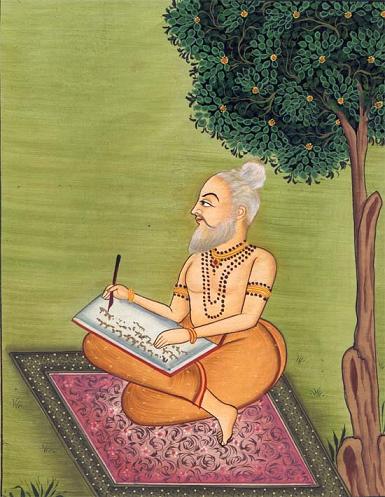BALMIKA (VALMIKI) Balmika, the Iow-caste person (Chandala) attained emancipation….. (Maru M. 5, p. 999) The sage Valmiki was the author of Ramayana. His place of residence was Chitra-kuta, a hill in the district of Banda in Bundelkund. When Sita was about to become a mother, she was left near the hermitage of Valmiki by Lakshmana. The sage kept her under the charge of his wife and female servants.
Sita\’s two sons, Lava and Kusha, were then bom in the hermitage of the saint. The young ones were brought up and given all the required education with the greatest care. The sage is said to have taught his poem to them. Thus the sage himself is one of the characters of Ramayana.
References :
1. Kohli, Surindar Singh, Dictionary of Mythological References in Guru Granth Sahib, 1993
Balmika
The Guru Granth Sahib, the sacred scripture of Sikhism, is a profound composition that draws on a wide array of spiritual, cultural, and mythological symbols to convey its timeless teachings. By referencing stories and figures familiar to diverse traditions, it fosters inclusivity and inspires moral and spiritual reflection. One such reference is to Balmika, a revered figure with deep mythological and historical significance.
In Hindu mythology and tradition, Balmiki (or Valmiki) is known as the composer of the Ramayana, one of the great epics of ancient India. Valmiki, a sage who attained spiritual enlightenment, is celebrated not only for his poetic genius but also for his transformation from a life of struggle and sin to one of devotion and righteousness. His story serves as a powerful metaphor for the potential of human redemption through divine grace and self-realization.
In the Guru Granth Sahib, the reference to figures like Balmika underscores the transformative power of devotion and humility. Sikh philosophy aligns with the idea that individuals, regardless of their past, can attain spiritual liberation through faith, selfless service, and a connection to the Divine. The scripture consistently emphasizes the equality of all individuals and the possibility of redemption for everyone, reflecting the inclusive and compassionate vision of the Sikh Gurus.
By invoking a figure like Balmika, the Guru Granth Sahib transcends religious and cultural boundaries, reinterpreting traditional stories to illustrate universal truths. It teaches that true enlightenment comes not through birth or status but through a life of virtue, humility, and unwavering faith in the Creator.
In conclusion, the reference to Balmika in the Guru Granth Sahib exemplifies its inclusive spirit and its ability to draw on diverse cultural symbols to convey profound spiritual lessons. Through such references, it inspires seekers to embrace the transformative journey of self-awareness, devotion, and unity with the Divine.




